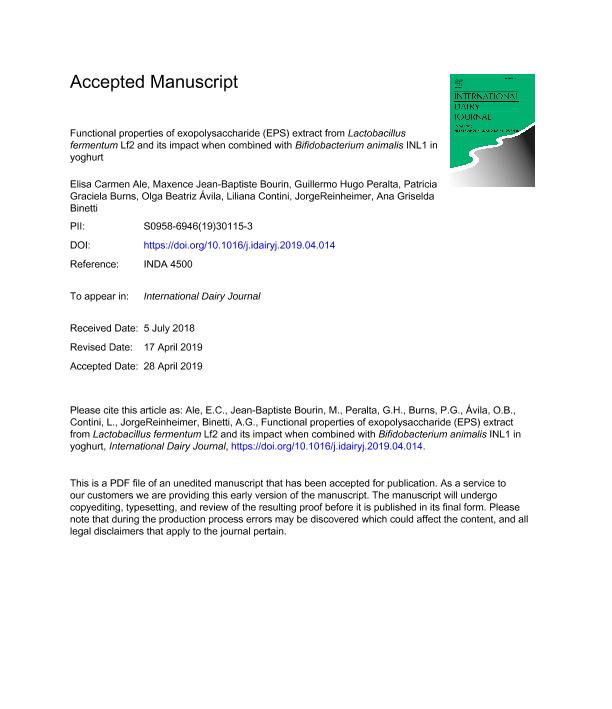Mostrar el registro sencillo del ítem
dc.contributor.author
Ale, Elisa Carmen

dc.contributor.author
Maxence J. Bourin
dc.contributor.author
Peralta, Guillermo Hugo

dc.contributor.author
Burns, Patricia Graciela

dc.contributor.author
Avila, Olga Beatriz

dc.contributor.author
Contini, Liliana Ester

dc.contributor.author
Reinheimer, Jorge Alberto

dc.contributor.author
Binetti, Ana Griselda

dc.date.available
2020-07-23T14:07:27Z
dc.date.issued
2019-04
dc.identifier.citation
Ale, Elisa Carmen; Maxence J. Bourin; Peralta, Guillermo Hugo; Burns, Patricia Graciela; Avila, Olga Beatriz; et al.; Functional properties of exopolysaccharide (EPS) extract from Lactobacillus fermentum Lf2 and its impact when combined with Bifidobacterium animalis INL1 in yoghurt; Elsevier; International Dairy Journal; 96; 4-2019; 114-125
dc.identifier.issn
0958-6946
dc.identifier.uri
http://hdl.handle.net/11336/110001
dc.description.abstract
In the present work, the functional roles of an exopolysaccharide (EPS) extract form Lactobacillus fermentum Lf2 were studied by means of in vitro and in vivo assays, individually or combined with a probiotic strain, Bifidobacterium animalis subsp. lactis INL1. From the in vitro assay (macrophages derived from THP-1 cell line), the EPS in its purified form caused an increase in the levels of the proinflammatory cytokine TNFα, while both forms of EPS (purified and crude) produced an increase in the regulatory cytokine IL-10, evidencing an immunomodulatory role. To study the functional role of EPS as a food ingredient, an in vivo assay was done with mice (BALB/c) that received yogurt with EPS (600 mg L-1, YE), with bifidobacteria (5x108 CFU mL-1, YB), a combination of both ingredients (YEB), or yogurt with no additives (Y), for 25 days. The level of diverse bacterial groups and Short Chain Faty Acids (SCFA) were estimated in faeces, and s-IgA and cytokines were determined in small intestine. Among the four groups, only the group YE presented significantly increased concentrations of acetic and butyric acids, together with an increase in the total SCFA (p< 0.05), through the time of treatment. The levels of the C. coccoides cluster (SCFA producing group) rose over time (p< 0.05) for this group as well. When the combination of both ingredients was studied (YEB), a possible bifidogenic role was observed, reflected in the increasing levels of the genus Bifidobacterium along time (p< 0.05), a behaviour that was not observed when the probiotic was administered solely (group YB). But, in this case, no significant differences were observed for the concentration of SCFA. These results highlight the promising application of this EPS as a functional food ingredient: with prebiotic or synbiotic potential roles, when administered individually (due to its effects on the SCFA levels) or combined with B. animalis subsp. lactis INL1 (considering the increase of Bifidobacteria during the time of treatment), respectively.
dc.format
application/pdf
dc.language.iso
eng
dc.publisher
Elsevier

dc.rights
info:eu-repo/semantics/openAccess
dc.rights.uri
https://creativecommons.org/licenses/by-nc-sa/2.5/ar/
dc.subject
EXOPOLYSACCHARIDES
dc.subject
SYNBIOTIC EFFECT
dc.subject
PREBIOTIC PROPERTIES
dc.subject
L. FERMENTUM
dc.subject.classification
Alimentos y Bebidas

dc.subject.classification
Otras Ingenierías y Tecnologías

dc.subject.classification
INGENIERÍAS Y TECNOLOGÍAS

dc.title
Functional properties of exopolysaccharide (EPS) extract from Lactobacillus fermentum Lf2 and its impact when combined with Bifidobacterium animalis INL1 in yoghurt
dc.type
info:eu-repo/semantics/article
dc.type
info:ar-repo/semantics/artículo
dc.type
info:eu-repo/semantics/publishedVersion
dc.date.updated
2020-07-20T16:23:47Z
dc.journal.volume
96
dc.journal.pagination
114-125
dc.journal.pais
Países Bajos

dc.journal.ciudad
Amsterdam
dc.description.fil
Fil: Ale, Elisa Carmen. Consejo Nacional de Investigaciones Científicas y Técnicas. Centro Científico Tecnológico Conicet - Santa Fe. Instituto de Lactología Industrial. Universidad Nacional del Litoral. Facultad de Ingeniería Química. Instituto de Lactología Industrial; Argentina
dc.description.fil
Fil: Maxence J. Bourin. University College Cork; Irlanda
dc.description.fil
Fil: Peralta, Guillermo Hugo. Consejo Nacional de Investigaciones Científicas y Técnicas. Centro Científico Tecnológico Conicet - Santa Fe. Instituto de Lactología Industrial. Universidad Nacional del Litoral. Facultad de Ingeniería Química. Instituto de Lactología Industrial; Argentina
dc.description.fil
Fil: Burns, Patricia Graciela. Consejo Nacional de Investigaciones Científicas y Técnicas. Centro Científico Tecnológico Conicet - Santa Fe. Instituto de Lactología Industrial. Universidad Nacional del Litoral. Facultad de Ingeniería Química. Instituto de Lactología Industrial; Argentina
dc.description.fil
Fil: Avila, Olga Beatriz. Universidad Nacional del Litoral. Facultad de Bioquímica y Ciencias Biológicas; Argentina
dc.description.fil
Fil: Contini, Liliana Ester. Universidad Nacional del Litoral. Facultad de Bioquímica y Ciencias Biológicas; Argentina
dc.description.fil
Fil: Reinheimer, Jorge Alberto. Consejo Nacional de Investigaciones Científicas y Técnicas. Centro Científico Tecnológico Conicet - Santa Fe. Instituto de Lactología Industrial. Universidad Nacional del Litoral. Facultad de Ingeniería Química. Instituto de Lactología Industrial; Argentina
dc.description.fil
Fil: Binetti, Ana Griselda. Consejo Nacional de Investigaciones Científicas y Técnicas. Centro Científico Tecnológico Conicet - Santa Fe. Instituto de Lactología Industrial. Universidad Nacional del Litoral. Facultad de Ingeniería Química. Instituto de Lactología Industrial; Argentina
dc.journal.title
International Dairy Journal

dc.relation.alternativeid
info:eu-repo/semantics/altIdentifier/url/https://www.sciencedirect.com/science/article/pii/S0958694619301153
dc.relation.alternativeid
info:eu-repo/semantics/altIdentifier/doi/http://dx.doi.org/10.1016/j.idairyj.2019.04.014
Archivos asociados
